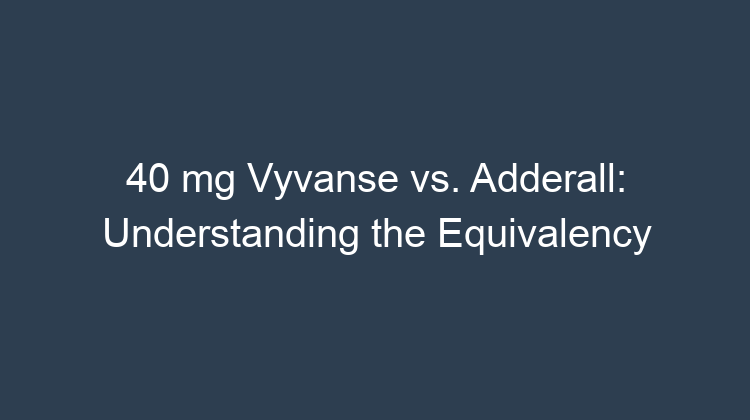Vyvanse and Adderall, both central nervous system stimulants, are commonly prescribed medications for treating conditions like ADHD (Attention Deficit Hyperactivity Disorder). While both drugs share similarities in their effects, there are key differences between them, including variations in dosage and potency. Understanding the equivalency between 40 mg of Vyvanse and Adderall is essential for healthcare providers and patients alike to optimize treatment outcomes and minimize potential adverse effects.
Vyvanse, also known as lisdexamfetamine dimesylate, is a prodrug of dextroamphetamine, which is the active ingredient in Adderall. This means that Vyvanse undergoes metabolic conversion in the body to release dextroamphetamine gradually over several hours, providing a sustained and controlled release of the medication. Adderall, on the other hand, is a combination of dextroamphetamine and amphetamine salts, offering a more immediate and shorter duration of action.
When it comes to dosage, the equivalency between 40 mg of Vyvanse and Adderall is not straightforward. Due to differences in their chemical composition and pharmacokinetic properties, a direct comparison cannot be made. The appropriate dosage of each medication depends on various factors, including individual patient characteristics, symptom severity, and treatment goals. It’s crucial to consult with a healthcare provider to determine the most suitable dosage and medication for each patient.
Drug Comparison: 40 mg Vyvanse and Adderall
2.1 Pharmacological Mechanism
Vyvanse and Adderall work by increasing the levels of certain neurotransmitters in the brain, primarily dopamine and norepinephrine. These neurotransmitters play crucial roles in attention, focus, and behavioral control. By enhancing their levels, both medications aim to alleviate symptoms of ADHD, such as inattention, hyperactivity, and impulsivity.
2.2 Duration of Action
The duration of action is a significant difference between Vyvanse and Adderall. Vyvanse provides a longer-lasting effect due to its controlled-release formulation, typically lasting up to 12 hours or more. This sustained release profile allows for once-daily dosing, improving patient compliance and reducing the need for multiple doses throughout the day.
Adderall, on the other hand, has a shorter duration of action, usually lasting 4 to 6 hours. This necessitates more frequent dosing, typically two to three times a day, to maintain therapeutic effects throughout the day. The shorter duration of action may be advantageous for individuals who need flexibility in their dosing schedule or prefer shorter-acting medications.
2.3 Side Effects and Tolerability
The side effect profile of Vyvanse and Adderall can vary among individuals. Both medications may cause common side effects such as decreased appetite, insomnia, and increased heart rate. However, Vyvanse is generally considered to be better tolerated, with a lower risk of certain side effects, such as anxiety, jitteriness, and cardiovascular issues. This may be attributed to its gradual release mechanism, which results in a smoother and more sustained effect.
40 mg Vyvanse vs. Adderall: Clinical Considerations
3.1 Dosing Adjustment
Dosing adjustment is an important aspect to consider when comparing 40 mg of Vyvanse and Adderall. The appropriate dosage for each individual may vary depending on various factors, including age, weight, and response to the medication. It’s essential to work closely with a healthcare provider to determine the optimal dosage and adjust it as needed to achieve the desired therapeutic effects while minimizing potential adverse reactions.
3.2 Drug Interactions
Both Vyvanse and Adderall have the potential to interact with other medications, supplements, or foods. It’s crucial to disclose all current medications, including over-the-counter drugs and herbal supplements, to a healthcare provider before starting treatment. Certain medications, such as antidepressants, antipsychotics, and blood thinners, may interact with Vyvanse or Adderall, affecting their efficacy or safety.
3.3 Monitoring and Follow-Up
Regular monitoring and follow-up are essential when taking Vyvanse or Adderall. Healthcare providers may recommend periodic assessments to evaluate treatment progress, monitor for potential side effects, and adjust the dosage as needed. Patients should adhere to the prescribed dosing schedule and report any new or worsening symptoms promptly. Long-term use of these medications may require ongoing monitoring to ensure continued safety and effectiveness.
FAQ: Understanding Vyvanse and Adderall
4.1 What is the main difference between Vyvanse and Adderall?
The main difference between Vyvanse and Adderall lies in their duration of action. Vyvanse provides a longer-lasting effect due to its controlled-release formulation, while Adderall has a shorter duration of action and requires more frequent dosing.
4.2 Is 40 mg of Vyvanse the same as 40 mg of Adderall?
No, 40 mg of Vyvanse is not equivalent to 40 mg of Adderall. Due to differences in their chemical composition and pharmacokinetic properties, a direct comparison cannot be made. The appropriate dosage of each medication depends on various individual factors and should be determined by a healthcare provider.
4.3 Which medication has a lower risk of side effects, Vyvanse or Adderall?
Vyvanse is generally considered to be better tolerated than Adderall, with a lower risk of certain side effects, such as anxiety, jitteriness, and cardiovascular issues. This is likely due to its gradual release mechanism, which results in a smoother and more sustained effect.
4.4 Can I switch from Vyvanse to Adderall or vice versa?
Switching from Vyvanse to Adderall or vice versa should only be done under the supervision of a healthcare provider. The appropriate medication and dosage may vary depending on individual needs and responses. Sudden changes in medication or dosage should be avoided to minimize potential adverse effects.
4.5 How long does it take for Vyvanse and Adderall to start working?
The onset of action can vary among individuals and depends on factors such as dosage and individual metabolism. Vyvanse typically takes longer to reach its full effect, usually within 1 to 2 hours, due to its controlled-release mechanism. Adderall, on the other hand, has a more rapid onset of action, typically within 30 minutes to 1 hour.
Conclusion: Understanding the Equivalency
Understanding the equivalency between 40 mg of Vyvanse and Adderall requires careful consideration of multiple factors, including the duration of action, side effect profile, and individual patient







